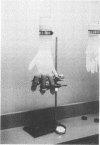Abstract
This study evaluated bacteriophages phi X174, T7, PRD1, and phi 6 as possible surrogates for pathogenic human viruses to challenge barrier materials and demonstrated some important factors for their use. Chemical incompatibility with test material was demonstrated when lipid-enveloped phi 6 was inactivated by an aqueous eluate of vinyl gloves, but 0.5% calf serum protected phi 6 from the eluate. Low concentrations (2%) of calf serum also prevented the exaggerated binding of the bacteriophages to filters. Recovery of viruses from surfaces decreased with increasing time before recovery. Penetration through punctures displayed different types of kinetics. The combined data indicate that (i) some bacteriophages may serve as surrogate viruses, (ii) experimental conditions determine whether a particular virus is appropriate as a challenge, and (iii) phi X174 is an excellent choice as a surrogate virus to test barrier materials. The data further indicate that before barrier materials are challenged with viruses, adequate tests should be performed to ensure that the virus is compatible with the test material and test conditions, so that meaningful data will result.
Full text
PDF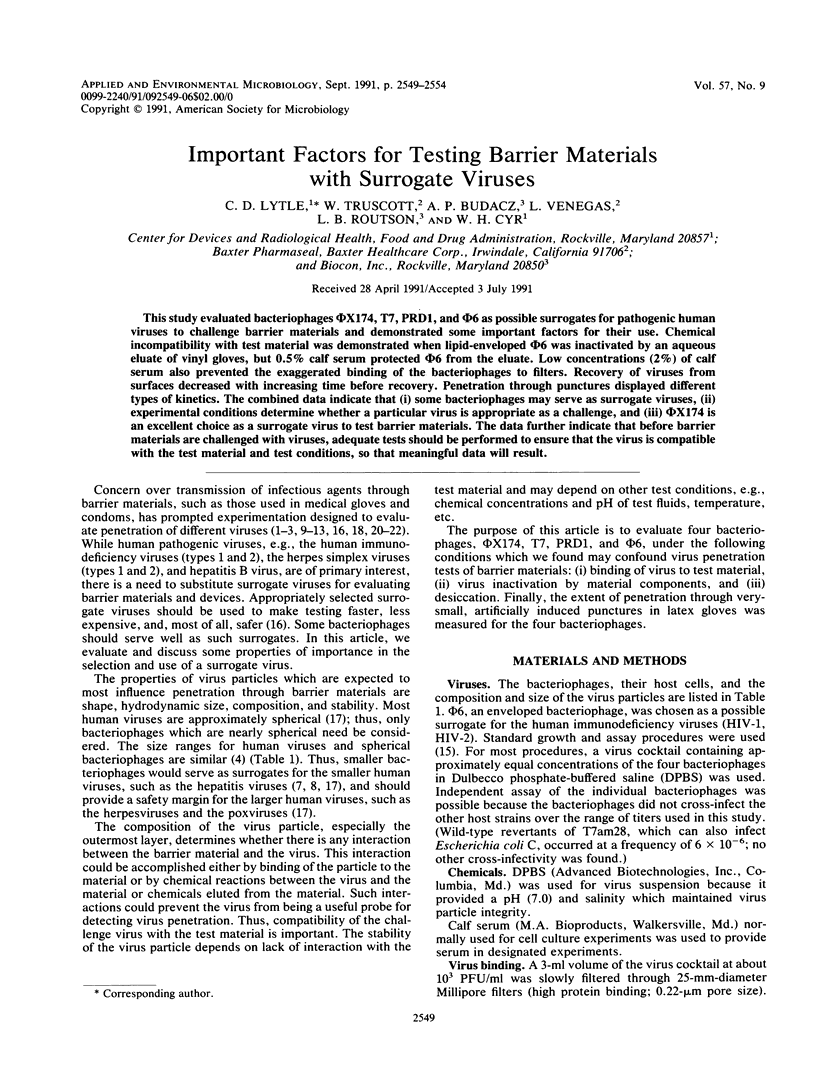
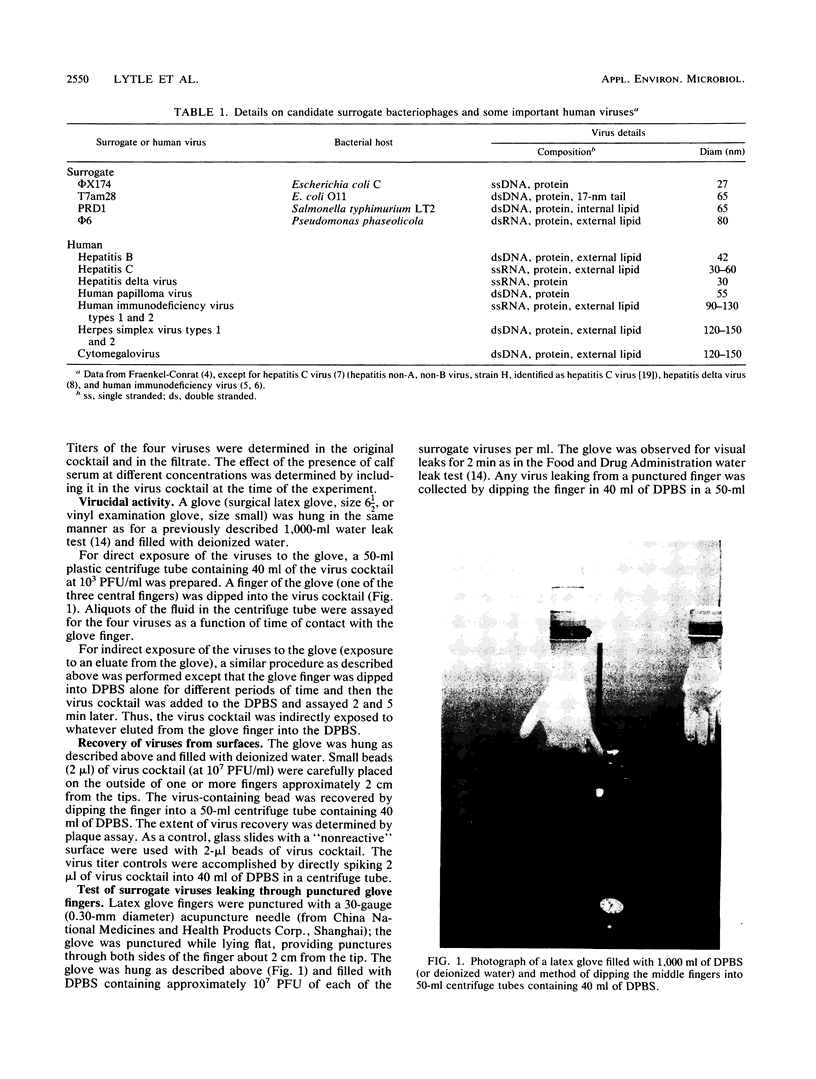
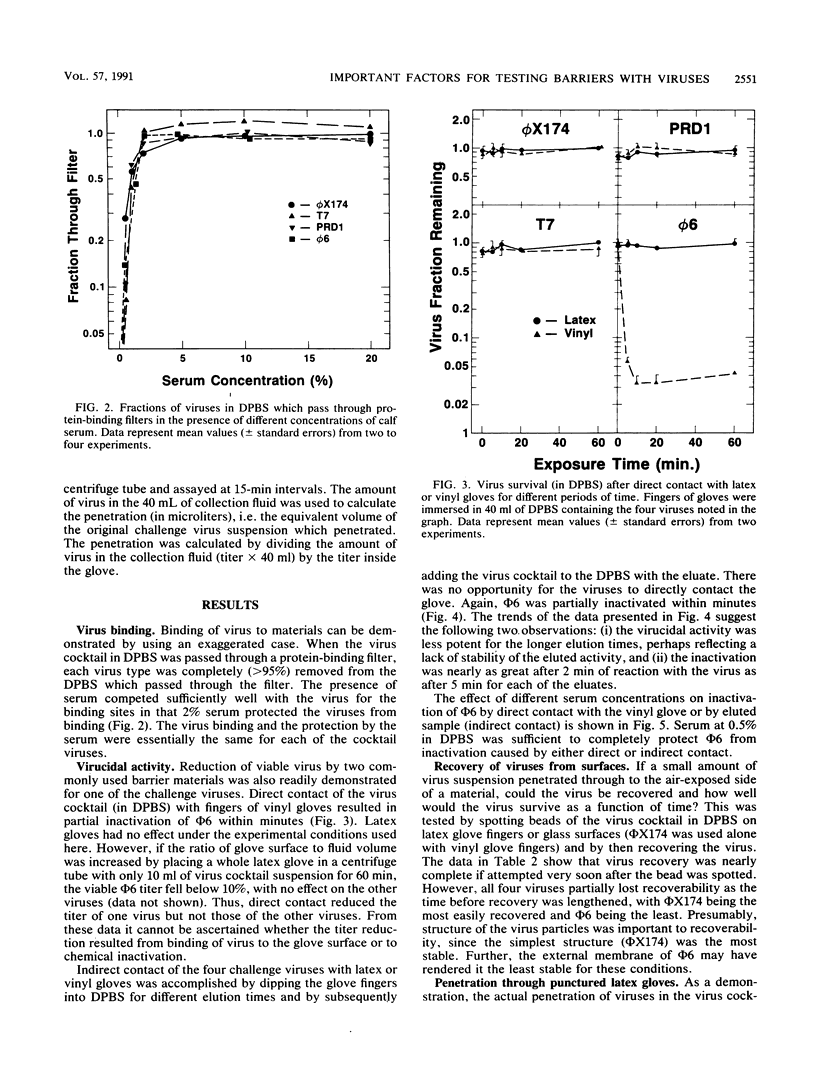
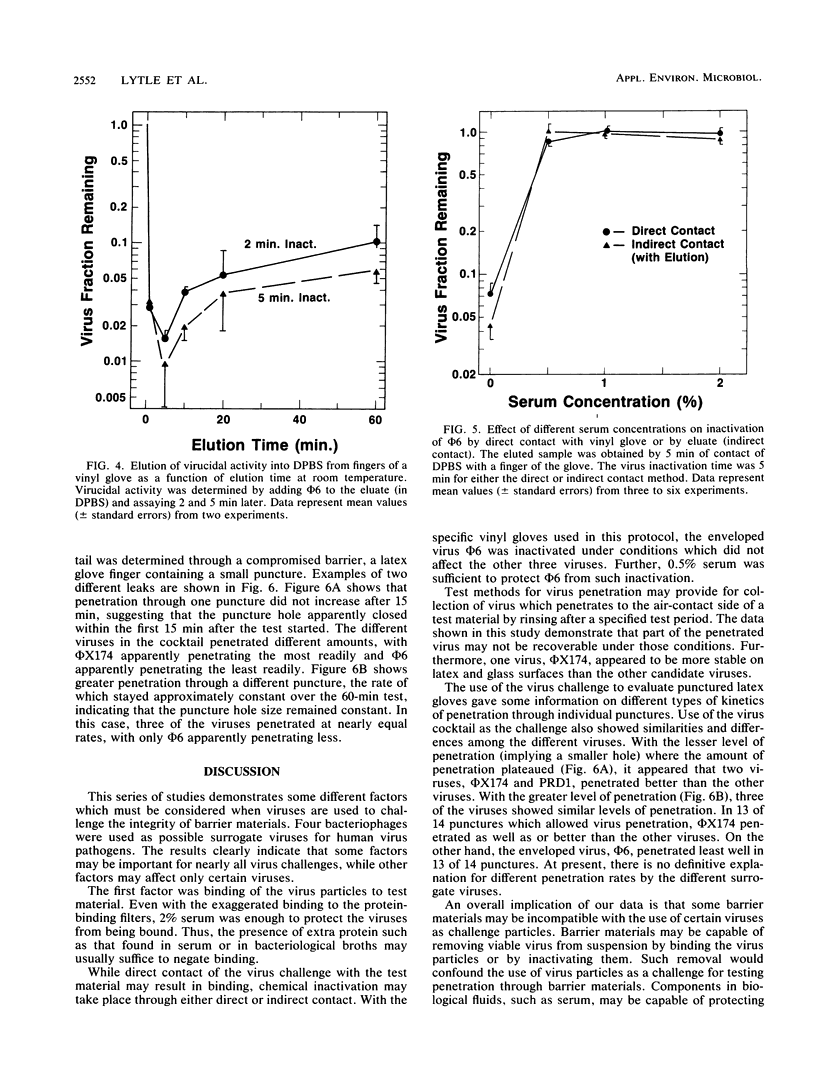
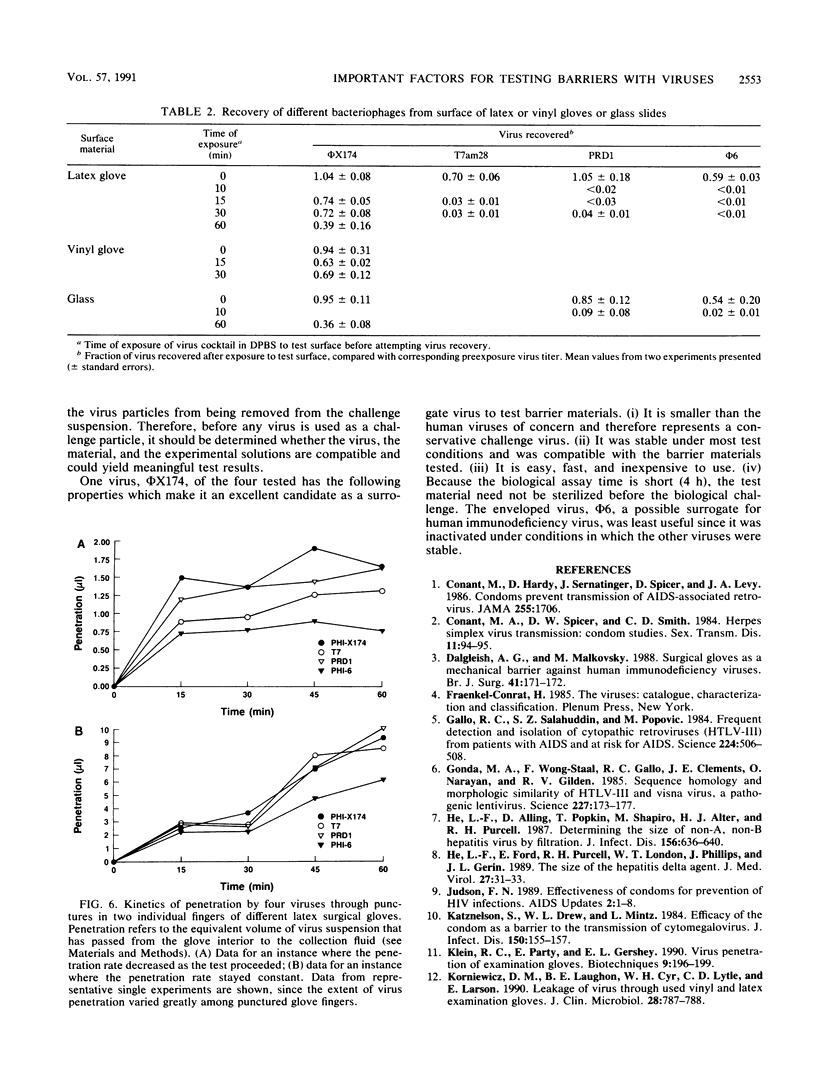
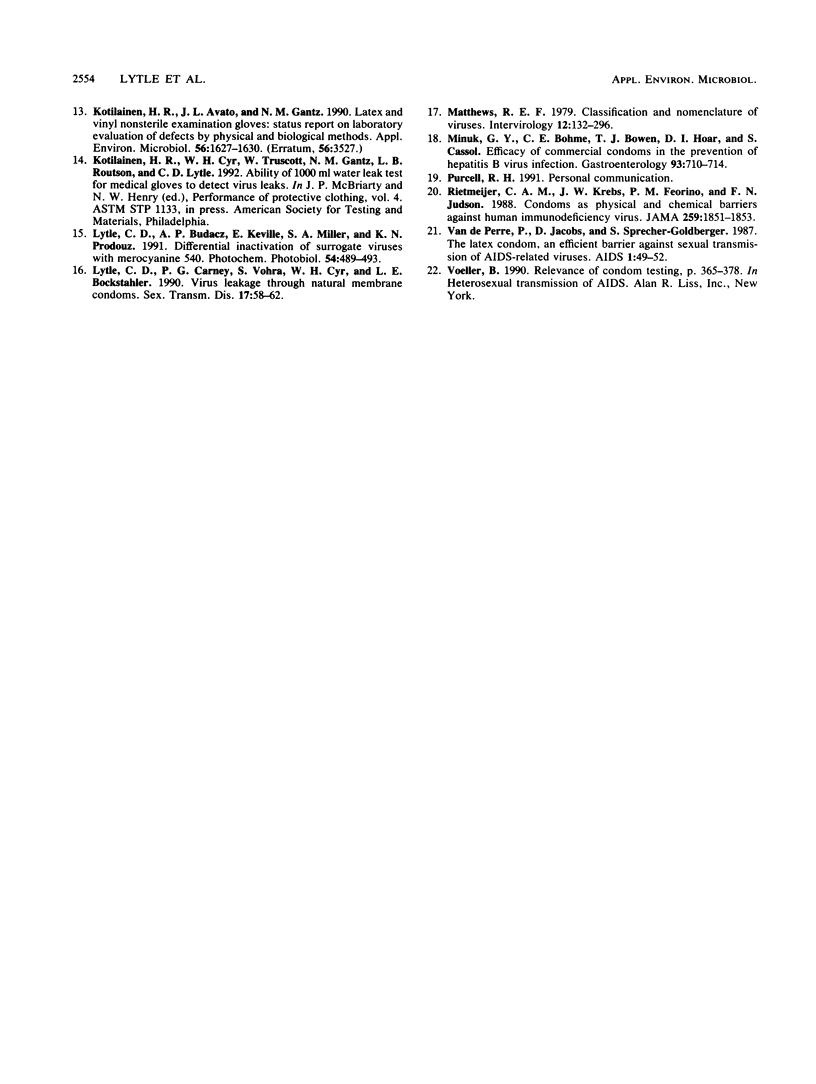
Images in this article
Selected References
These references are in PubMed. This may not be the complete list of references from this article.
- Conant M. A., Spicer D. W., Smith C. D. Herpes simplex virus transmission: condom studies. Sex Transm Dis. 1984 Apr-Jun;11(2):94–95. doi: 10.1097/00007435-198404000-00009. [DOI] [PubMed] [Google Scholar]
- Conant M., Hardy D., Sernatinger J., Spicer D., Levy J. A. Condoms prevent transmission of AIDS-associated retrovirus. JAMA. 1986 Apr 4;255(13):1706–1706. [PubMed] [Google Scholar]
- Dalgleish A. G., Malkovsky M. Surgical gloves as a mechanical barrier against human immunodeficiency viruses. Br J Surg. 1988 Feb;75(2):171–172. doi: 10.1002/bjs.1800750229. [DOI] [PubMed] [Google Scholar]
- Gonda M. A., Wong-Staal F., Gallo R. C., Clements J. E., Narayan O., Gilden R. V. Sequence homology and morphologic similarity of HTLV-III and visna virus, a pathogenic lentivirus. Science. 1985 Jan 11;227(4683):173–177. doi: 10.1126/science.2981428. [DOI] [PubMed] [Google Scholar]
- He L. F., Alling D., Popkin T., Shapiro M., Alter H. J., Purcell R. H. Determining the size of non-A, non-B hepatitis virus by filtration. J Infect Dis. 1987 Oct;156(4):636–640. doi: 10.1093/infdis/156.4.636. [DOI] [PubMed] [Google Scholar]
- He L. F., Ford E., Purcell R. H., London W. T., Phillips J., Gerin J. L. The size of the hepatitis delta agent. J Med Virol. 1989 Jan;27(1):31–33. doi: 10.1002/jmv.1890270107. [DOI] [PubMed] [Google Scholar]
- Katznelson S., Drew W. L., Mintz L. Efficacy of the condom as a barrier to the transmission of cytomegalovirus. J Infect Dis. 1984 Jul;150(1):155–157. doi: 10.1093/infdis/150.1.155. [DOI] [PubMed] [Google Scholar]
- Klein R. C., Party E., Gershey E. L. Virus penetration of examination gloves. Biotechniques. 1990 Aug;9(2):196–199. [PubMed] [Google Scholar]
- Korniewicz D. M., Laughon B. E., Cyr W. H., Lytle C. D., Larson E. Leakage of virus through used vinyl and latex examination gloves. J Clin Microbiol. 1990 Apr;28(4):787–788. doi: 10.1128/jcm.28.4.787-788.1990. [DOI] [PMC free article] [PubMed] [Google Scholar]
- Kotilainen H. R., Avato J. L., Gantz N. M. Latex and vinyl nonsterile examination gloves: status report on laboratory evaluation of defects by physical and biological methods. Appl Environ Microbiol. 1990 Jun;56(6):1627–1630. doi: 10.1128/aem.56.6.1627-1630.1990. [DOI] [PMC free article] [PubMed] [Google Scholar]
- Lytle C. D., Budacz A. P., Keville E., Miller S. A., Prodouz K. N. Differential inactivation of surrogate viruses with merocyanine 540. Photochem Photobiol. 1991 Sep;54(3):489–493. doi: 10.1111/j.1751-1097.1991.tb02047.x. [DOI] [PubMed] [Google Scholar]
- Lytle C. D., Carney P. G., Vohra S., Cyr W. H., Bockstahler L. E. Virus leakage through natural membrane condoms. Sex Transm Dis. 1990 Apr-Jun;17(2):58–62. doi: 10.1097/00007435-199004000-00002. [DOI] [PubMed] [Google Scholar]
- Matthews R. E. Third report of the International Committee on Taxonomy of Viruses. Classification and nomenclature of viruses. Intervirology. 1979;12(3-5):129–296. doi: 10.1159/000149081. [DOI] [PubMed] [Google Scholar]
- Minuk G. Y., Bohme C. E., Bowen T. J., Hoar D. I., Cassol S., Gill M. J., Clarke H. C. Efficacy of commercial condoms in the prevention of hepatitis B virus infection. Gastroenterology. 1987 Oct;93(4):710–714. doi: 10.1016/0016-5085(87)90431-8. [DOI] [PubMed] [Google Scholar]
- Rietmeijer C. A., Krebs J. W., Feorino P. M., Judson F. N. Condoms as physical and chemical barriers against human immunodeficiency virus. JAMA. 1988 Mar 25;259(12):1851–1853. [PubMed] [Google Scholar]
- Sarngadharan M. G., Popovic M., Bruch L., Schüpbach J., Gallo R. C. Antibodies reactive with human T-lymphotropic retroviruses (HTLV-III) in the serum of patients with AIDS. Science. 1984 May 4;224(4648):506–508. doi: 10.1126/science.6324345. [DOI] [PubMed] [Google Scholar]
- Van de Perre P., Jacobs D., Sprecher-Goldberger S. The latex condom, an efficient barrier against sexual transmission of AIDS-related viruses. AIDS. 1987 May;1(1):49–52. [PubMed] [Google Scholar]



